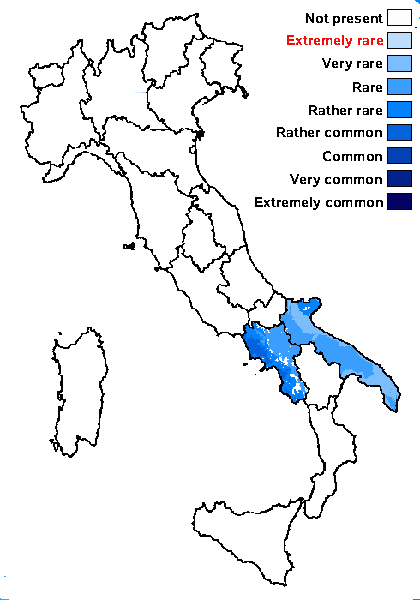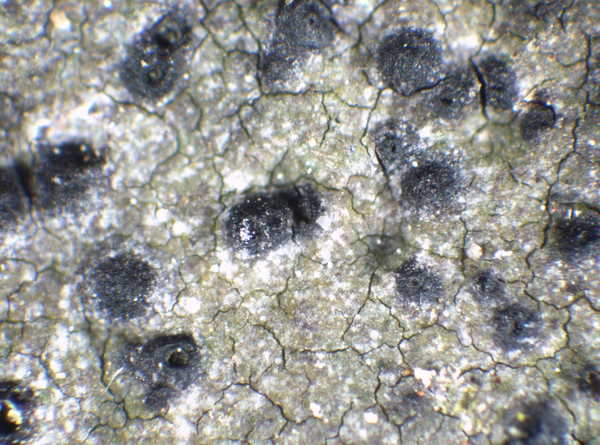Porina provincialis (Clauzade & Cl. Roux) Cl. Roux
in Roux & al., Bull. Soc. linn. Provence, 54: 131, 2003. Basionym: Porina oleriana var. provincialis Clauzade & Cl. Roux - Bull. Soc. Bot. Centre-Ouest, n. sér., nr. spéc. 7: 823, 1985.
Synonyms:
Distribution: N - VG (TSB 34051). S - Camp (TSB 31922), Pugl (TSB 22557).
Description: Thallus crustose, endosubstratic or more frequently thinly episubstratic, greenish to reddish brown, almost continuous or finely cracked in older parts, adjacent thalli being often separated by a black line. Perithecia black, 0.2-0.4 mm across, c. one third-immersed in the rock. Involucrellum of thick-walled, more or less elongated cells, violaceous brown to black, adhering to the exciple and reaching the base of the perithecium; exciple colourless to pale brown; hamathecium of simple paraphyses; hymenial gel I-, K/I-. Asci 8-spored, clavate-cylindrical, thin-walled throughout, functionally unitunicate, dehiscent by rupture of the apex, with no extruded inner layers, I-, K/I-. Ascospores transversely 6-8-septate, exceptionally with an additional longitudinal septum, hyaline, fusiform, with one end usually broader than the other, 26-44 x 6-9 µm. Photobiont trentepohlioid. Spot tests: thallus K-, C-, KC-, P-, UV-. Chemistry: thallus without lichen substances.Note: on shaded surfaces of calcareous or dolomitic rocks in lowland areas.
Growth form: Crustose
Substrata: rocks
Photobiont: Trentepohlia
Reproductive strategy: mainly sexual
Commonnes-rarity: (info)
Alpine belt: absent
Subalpine belt: absent
Oromediterranean belt: absent
Montane belt: absent
Submediterranean belt: rare
Padanian area: absent
Humid submediterranean belt: rather rare
Humid mediterranean belt: rather common
Dry mediterranean belt: very rare

Predictive model
Herbarium samples
Growth form: Crustose
Substrata: rocks
Photobiont: Trentepohlia
Reproductive strategy: mainly sexual
Commonnes-rarity: (info)
Alpine belt: absent
Subalpine belt: absent
Oromediterranean belt: absent
Montane belt: absent
Submediterranean belt: rare
Padanian area: absent
Humid submediterranean belt: rather rare
Humid mediterranean belt: rather common
Dry mediterranean belt: very rare

Predictive model
| Herbarium samples |
 INDEX FUNGORUM
INDEX FUNGORUM
 GBIF
GBIF



